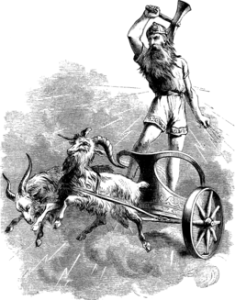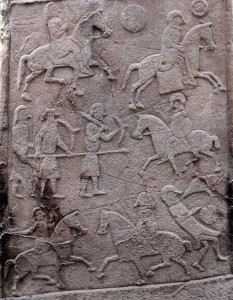Stories Latent in the Landscape: Spirits, Time Slips, and “Super-Psi”
An alternative explanation sometimes given when mediums provide veridical information about deceased persons is “super-psi”—the idea that the medium is actually obtaining the information clairvoyantly and/or telepathically (i.e., from the heads of their sitters). Super-psi has also been used to account for cases of apparent reincarnation: A child psychically acquires information about a dead person and identifies with that person, producing the appearance of actually being that person in a new life and body. Super-psi explanations satisfy the modern rationalist wish not to appeal to life after death as an explanation for these kinds of phenomena; but as Stephen Braude notes in his fascinating study of the evidence for survival of bodily death, Immortal Remains, it can produce highly convoluted explanations that fail the test of parsimony in comparison to the frankly simpler survival account.
If there is an emotionally powerful story lying in wait for us, some past tragic event just waiting to be learned about or pieced together in our near future, it may elicit a precognitive experience.
I think the problem is that making psi “super” precisely sets it up to fail. I am starting to think that the more different things we allow psi to be, and the more omniscient we pretend psychics are, the less compelling psi is as an explanation for anything. The current vogue for nonlocality as an explanatory framework in parapsychology ignores basic questions of information search and retrieval: How is it that a psychic (or anybody, insofar as we are all psychic) can select a specific piece of information in a whole universe of information and recognize it as the right answer? A much simpler and more powerful explanation for some mediumship cases is the reductive, even Pavlovian framework I proposed in the context of Thomas Pynchon’s Gravity’s Rainbow: What may seem like telepathy or clairvoyance or any number of other ESP or spiritualist phenomena could be simply producing behaviors or descriptions that are tied to future rewards. Those rewards could include future exciting feedback and other learning experiences.
I have written about this in literary contexts, but other forms of learning, including the consulting of archives or just “learning the truth” through some vivid interpersonal disclosure, should have the same effect. If there is a vivid and emotionally powerful story lying in wait for us, some past dramatic or tragic event just waiting to be learned about or pieced together in our near future, it may elicit a precognitive experience that we will mistake as “synchronicity” or perhaps interpret as a past-life experience, or construct in some other culturally less taboo way than precognition.
The story of “Runki’s leg,” for example, is a nice example from the late 1930s in Iceland, which some take as compelling evidence for survival. It seems to me instead like a vivid case of prophetic jouissance, the engagement of a talented Icelandic “precog” with a compelling and culturally potent story latent in his community and landscape. It is a perfect illustration of the power of ancient myths, archives, and geography to intersect and generate, almost like a hologram, precognitive experiences in a gifted psychic sleuth who, quite naturally and according to his cultural tradition, thought of himself as channeling a dead spirit.
Super-Psi Me
The story is told in a 1975 A.S.P.R. article by Erlandur Haraldsson and Ian Stevenson and examined at length by Braude in his book. Hafsteinn Bjornsson was a noted trance medium who, in a series of Reykjavik seances beginning in Fall 1937, began channeling a “drop-in” personality who complained that was looking for his missing leg that was lost in the sea. (A typical feature of “drop-in” personalities is that they are unexpected and display a strong motive for communicating with the living.) This personality was unwilling or unable to further clarify what he meant, or even give his real name, but he persistently appeared during Hafsteinn’s trances asking for his leg over the next year.
A culture that makes a place for spirit mediumship has arguably created an open channel of precognitive information.
Then on January 1, 1939, when a fish merchant named Ludvik Gudmondsson (previously unknown to Hafsteinn) joined the seance circle, the mysterious legless personality announced that his missing leg was in Ludvik’s house, in a town called Sandgerdi (about 36 miles away). Ludvik indeed had purchased a large house there, but knew nothing about a missing leg. After Ludvik demanded to know who the communicator was, the legless drop-in fell silent for some months, but eventually reappeared and told his whole story: His name, he said, was Runolfur Runolfsson, “Runki” for short, and in 1879 he had drowned after passing out drunk on the shore; his body had washed out to sea and then washed up some time later, but was found picked apart by animals with the thigh bone missing. The bone had, he said, washed up later in Sandgerdi, and after being “passed around,” ended up in Ludvik’s house.
“Runki” said his story could be confirmed by checking the records of a church in a town just a few miles from Sandgerdi, which were then housed in Reykjavik’s national archives. The sitters did this, and found that the drop-in’s narrative partly corresponded to the records: Runolfur Ronolfsson had been a tall Sandgerdi local who disappeared in 1879 and whose decomposed and partially dismembered body had been found on the beach over a year after his disappearance. Ludvik meanwhile inquired among elders in the town about a mysterious femur. Older residents recalled that indeed such a bone had been “going around” during the 1920s. In Norse communities, as in many European societies, a person (or an animal) could not be resurrected intact without their skeleton being whole (more on this detail below), so the townspeople wouldn’t just dispose of a human bone. Eventually, the townfolk said, a carpenter had placed the femur in an interior wall of the house that Ludvik eventually purchased. When they opened the wall in 1940, they found the bone, and gave it a proper burial in the same cemetery where Runolfur Runolfsson had been interred, although his exact gravesite had been forgotten. “Runki’s leg” was thus finally laid to rest. It is important to remember that, although the femur was long, corresponding to a tall person fitting Runki’s description, there is no proof that the bone was really Runki’s.
 What was going on here? Assuming the medium had not done extensive research and then somehow maneuvered Ludvik to join his seance circle, how could he have known about Runki or the femur, other than through Runki’s departed spirit actually speaking through him? Haraldsson and Stevenson and Braude weigh this assumption against the super-psi alternative, that the medium was really obtaining telepathic information from the sitters. They naturally find the super-psi explanation wanting: Until they consulted the archives to confirm Runki’s story, none of Hafsteinn’s circle (as far as anyone knows) could have possessed the necessary information to enable the medium to telepathically extract it from their heads; and nobody present, even Ludvik, knew about the mysterious femur or how it ended up in Ludvik’s wall, and this detail was not part of the records at all.
What was going on here? Assuming the medium had not done extensive research and then somehow maneuvered Ludvik to join his seance circle, how could he have known about Runki or the femur, other than through Runki’s departed spirit actually speaking through him? Haraldsson and Stevenson and Braude weigh this assumption against the super-psi alternative, that the medium was really obtaining telepathic information from the sitters. They naturally find the super-psi explanation wanting: Until they consulted the archives to confirm Runki’s story, none of Hafsteinn’s circle (as far as anyone knows) could have possessed the necessary information to enable the medium to telepathically extract it from their heads; and nobody present, even Ludvik, knew about the mysterious femur or how it ended up in Ludvik’s wall, and this detail was not part of the records at all.
But they do not consider that the source of Hafsteinn’s information could have been nothing other than information he would come to read or hear about in his own future. It seems reasonable to me that the arc of his channeling of “Runki” represented his own excited engagement with a really cool mystery, a story latent in his landscape, that his own research and that of his sitters was helping piece together and finally “lay to rest” over the course of 1937-1940.
Leg Work
A directly pertinent fact is that Hafsteinn’s name appears in the visitor register of the national archives, where the church records were kept, but several months after the drop-in personality revealed who he was and how he died. Those church records are crucial parts of that latent story awaiting being pieced together by the medium. Crucially, when “Runki” revealed his life story, he told the group that he died at age 52. This was an error—he was shy of 51 when he died—but the same error appears in the church record. J.W. Dunne’s brilliant forensic work in An Experiment With Time showed how clues like number errors can reveal the true precognitive source of psychic dreams that look on the surface like telepathy or clairvoyance or even encounters with the departed. The errant age in this case reveals that Hafsteinn was most likely precognizing the records in the archives, which he may well have visited precisely to gain insight into the information he had previously channeled.
One of the implicit cultural models of the paranormal is the metaphor of the earth as a recording surface: When something tragic, violent, or sad occurs in a place, it is like making a groove in a record that can be replayed again.
Even if Hafsteinn had read the records beforehand, it would still not discredit him as a fraud, because they told only part of the story. The records did not mention the missing leg (only saying that Runki’s remains were dismembered), nor did they say anything about the femur that found its way into the walls of Ludvik’s house. That had to be revealed by Ludvik, doing his investigative “legwork” (so to speak). Importantly, Hafsteinn began producing this information over a year before Ludvik even arrived in his circle, and we can imagine that the initial communications about the missing leg were a kind of precognitive performance dimly adumbrating the future arrival of a man who would ultimately prove to be a key to a mystery somehow involving a leg and the sea.
The detail of a corpse minus a leg bone has particularly mythic resonances in Norse culture, a detail not mentioned by Haraldsson and Stevenson or by Braude. In his 12th Century prose Edda, Snorri Sturluson described how Thor and Loki, while staying for the night with a farmer, slaughtered Thor’s goats for a meal; the farmer’s son secretly reserved a thigh bone for himself and broke it open for the marrow. In the morning, Thor waved his hammer over the goat carcasses and they came back to life … except, one was now limping. Claude Lecouteux, discussing this story, writes that it is a widespread shamanic belief that the soul resides in the bones of a person or animal. (It is a belief that, according to Rene Schwaller, also has deep alchemical roots in Ancient Egypt, where the femur was regarded as the site of the fixed salt or seed, the true substrate or carrier of the individual’s unique and immortal consciousness.) The “skull and crossbones,” which we now use as a warning on poison bottles, was originally a symbol of the capacity for rebirth; the “crossbones” are femurs.
 Bracketing the question of survival and the afterlife, It is only a time-displacement between Hafsteinn’s utterances and their real or apparent confirmation that makes this (or many mediumistic performances) a paranormal phenomenon. A wonderful puzzle about a drowned man and a missing limb, awaiting being pieced together among various textual and oral history fragments, seems to have echoed back in time along the resonating thread of this talented psychic’s performative jouissance. “In character,” he produced bits and pieces of a puzzle, and only gradually did the larger picture take shape—which must be the great joy and fascination of being a medium, and is precisely why mediums’ information comes in fragments and why they sometimes are caught haunting archives where they can acquire needed confirmatory data. In other words, Hafsteinn’s “paranormally” gained information intermixed with information gained in the usual way, but that real-world confirmation was a necessary part of his performance, and probably the real target of his psi eyes. There seems no reason to doubt that in this case as in so many others, the medium genuinely believed he was channeling spirits, because that was his culture’s construction of mediumistically produced information.
Bracketing the question of survival and the afterlife, It is only a time-displacement between Hafsteinn’s utterances and their real or apparent confirmation that makes this (or many mediumistic performances) a paranormal phenomenon. A wonderful puzzle about a drowned man and a missing limb, awaiting being pieced together among various textual and oral history fragments, seems to have echoed back in time along the resonating thread of this talented psychic’s performative jouissance. “In character,” he produced bits and pieces of a puzzle, and only gradually did the larger picture take shape—which must be the great joy and fascination of being a medium, and is precisely why mediums’ information comes in fragments and why they sometimes are caught haunting archives where they can acquire needed confirmatory data. In other words, Hafsteinn’s “paranormally” gained information intermixed with information gained in the usual way, but that real-world confirmation was a necessary part of his performance, and probably the real target of his psi eyes. There seems no reason to doubt that in this case as in so many others, the medium genuinely believed he was channeling spirits, because that was his culture’s construction of mediumistically produced information.
All artists, when they are ‘cooking,’ have the experience that there is some “other” working through them. Writers feel it, singers feel it, sculptors feel it. And, duh, actors feel it. Mediums were the original actors, long before it occurred to anybody to neutralize the practice by calling it “art” and imagining it had no more significance than an evening’s entertainment. Spiritualism and occultism have preserved that special role, providing a safe haven for shamanism in the modern world, at least in some more open-minded cultural contexts like Iceland. Whether you want to think of channeled personalities like the “drop-in” Runki as authentic spirits of the dead or, like the somewhat more skeptical me, as actors’ personae, mediumship is a skilled performance that opens a real psi channel. Under pressure, any skilled performer like a medium is cooking, left brain fully occupied with the physical task, creating the necessary space for the right brain to summon tantalizing bits of information from the precognitive unconscious.
Thus a culture that makes a place for spirit mediumship has arguably created an open channel of precognitive information, even if it is interpreted differently, and even if that information inevitably comes amid a lot of misleading or useless debris.
Stonetapes
Not only bones but also stones and other landscape features can be the sites of “resurrection” of the dead or past events. One of the implicit cultural models of the paranormal is the metaphor of the earth as a recording surface: When something tragic, violent, or sad occurs in a place, it is like making a groove in a record, storing the experience so that it can be replayed again. The right set of circumstances, according to this metaphor, is like putting that record back on a turntable, or popping a tape into the tape deck; a sensitive person is like a phonograph needle or tape playhead enabling the playback.
The appealing idea that spacetime and stone can store memories of events is based on technological metaphors of the modern period … but that is reason we should be skeptical of the idea.
Some version of this metaphor is implicit in ghost stories and in the way we construe the possibility of the past to haunt the present: For instance, a person dies a premature or violent death and then their spirit is re-encountered in the vicinity of where they died. It might as well also be a template for “time slip” experiences, such as the Roman soldiers on a buried piece of Roman road seen by Henry Martindale in a York cellar, the aristocrats at Versailles reported by Charlotte Anne Moberly and Eleanor Jourdain (the famous “ghosts of the Trianon”), or my personal favorite, the aftermath of the Battle of Nechtansmere seen by a 55-year-old woman named E.F. Smith one snowy evening in 1950, on her way home from a cocktail party near the Scottish village of Dunichen.
The idea that spacetime and stone can store memories of events is appealing and “easy to think,” because it is based on technological metaphors of the modern period. But that alone is reason we should be skeptical of the idea. I’ve argued in the context of precognitive dreaming that when premodern philosophers believed the world was structured by an occult system of correspondences (aemulatio, coniunctiatio, analogia, convenientia, etc.), they had unknowingly identified instead the deep structuring rules by which the brain makes meaning by linking things in memory. Another crucial “similitude” between premodern cosmology and the neurobiology of memory is the role of place as a memory framework. Just as the classical art of memory ties to-be-learned material to real or imaginary “loci,” the sensory richness of environments serve as powerful memory associations; this is not because space stores events but because the hippocampus, the brain’s archivist, contains our neural place representations, our maps of space.
The linkage of paranormal phenomena and geography may thus reflect the role of space and place in our mnemonic functioning: If psi is really precognition, and precognition is “just” our memory for the future, then just as place activates memory, it should also activate “premories” of future experiences either in or about that place. What is often left out of ghost encounters and time-slip cases, but can occasionally be extracted or inferred, is the final “revelation” part of the story, where the witness learned “what it was” he or she saw, or learned some detail that provides a forensic clue that the true source of the vision is that scene of confirmation, not the actual historical event.
 For instance, the Scottish spinster, Miss Smith, knew, as did all residents of her village, that the plain beneath nearby Dunichen Hill was the traditional site of the lake called Nechtansmere and the battle fought on its shore between Picts and Northumbrians in 685 AD, described by Bede. When her case was investigated by an SPR member named James McHarg in 1971, she claimed she had only delved more deeply into the local history after she had her baffling experience. One of the specific details of her vision, a certain roundabout path the Pictish soldiers took as they skirted the ancient mere (long since drained and vanished), corresponded to a spur of the lake as it had been reconstructed by an archaeologist in a journal article Smith admitted reading during her research after the vision. Most tellingly, though, later scholarly consensus has moved the site of the battle to another place entirely; it is no longer thought to have occurred near Dunichen at all. Thus, Smith, perhaps rendered vulnerable by a combination of cold and drink, appears to have precognized historical and archaeological journal articles she read in her avid excitement to confirm or lend insight into her experience, rather than retro-cognizing a bloody battle that was inscribed record-groove-like in the Scottish landscape.
For instance, the Scottish spinster, Miss Smith, knew, as did all residents of her village, that the plain beneath nearby Dunichen Hill was the traditional site of the lake called Nechtansmere and the battle fought on its shore between Picts and Northumbrians in 685 AD, described by Bede. When her case was investigated by an SPR member named James McHarg in 1971, she claimed she had only delved more deeply into the local history after she had her baffling experience. One of the specific details of her vision, a certain roundabout path the Pictish soldiers took as they skirted the ancient mere (long since drained and vanished), corresponded to a spur of the lake as it had been reconstructed by an archaeologist in a journal article Smith admitted reading during her research after the vision. Most tellingly, though, later scholarly consensus has moved the site of the battle to another place entirely; it is no longer thought to have occurred near Dunichen at all. Thus, Smith, perhaps rendered vulnerable by a combination of cold and drink, appears to have precognized historical and archaeological journal articles she read in her avid excitement to confirm or lend insight into her experience, rather than retro-cognizing a bloody battle that was inscribed record-groove-like in the Scottish landscape.
Lost in the Mall
This model, precognizing material or intellectual rewards awaiting us in libraries or in the ground, would also explain how “radiesthesia” or dowsing works. You could even look at “Runki’s leg” as an elaborate case of dowsing: The femur was a mystery awaiting discovery in Ludvik’s wall, just as Ludvik himself was an unknown, unmet person awaiting arrival in Hafsteinn’s seance circle. “Runki” was, in effect, the character and the story that linked the two together. (I am about as poor a psychic as Hafteinn was a skilled one, but I have noticed that psi dreams take this same form: providing puzzle pieces that are the missing connection or short circuit between two latently related things.) Thus even if psi is not about direct “nonlocal” connection to other minds in the present, or to spirits, it is about future physical confluences, the imminent linking of things and people and places IRL, in real life, as well as relevant texts that tie them all together.
Could you effectively create paranormal phenomena by strategically planting made-up stories about places and people in archives?
This raises many interesting possibilities. For example, if hauntings and other paranormal phenomena don’t relate to past events and past lives but to our own future learning or reading experiences about those events or lives, what is to limit this effect to true stories? Could you effectively create paranormal phenomena by strategically planting made-up stories about places and people in archives?
A great experiment for some enterprising young parapsychologist would be to invent a story about a tragedy tied to a particular location, such as a spectacular suicide or murder with some unresolved element, and seed local archives with pieces of this story, ready to be “discovered” by anyone trying to get to the bottom of an uncanny experience. Would people start reporting hauntings in that location, because they spent time in the place and then “stumbled upon” a compelling uncanny story that pertained to it?
It would be a kind of retroactive hypnosis, and there is an analogy to be drawn here with the well-established protocol developed by U.C. Davis psychologist Elizabeth Loftus for creating false memories in research subjects—most famously, false childhood memories of being lost in a mall and rescued by an old woman. Loftus is no friend of paranormal researchers; her body of work has been deployed in the service of debunking abduction claims, precognitive dreams, and other paranormal phenomena. But her work, and especially her famous “lost in the mall” paradigm, is something all anomalists are wise to confront. Would a similar array of story fragments and corroboration by local expert confederates (the caretaker, the maid, the elderly gift shop clerk) have the effect of creating a ghost? Has something like this already been done, for instance as part of MKULTRA?
It helps—or indeed, is probably necessary—if the myth has a hole or incompleteness in it that can be filled imaginatively by the reader himself, acting a part in the drama. The most powerful stories and myths are those that lack resolution, leaving a sense of something incomplete and thus haunting, something that might return, not unlike an unfinished chord progression … or Runki’s missing thigh bone. (More on this idea in a future post.)







Immortal Remains is certainly an interesting book, and represents a fair survey of parapsychological investigations while examining the extent of convergence between the multiple lines of evidence for survival. Indeed, I blame or credit it for starting me off down all those lines, along with a number of others. Regardless, Runki’s leg is certainly one of the most memorable cases in a book that contains a number of them. The mistaken ‘facts’ which are only true in the extant registers (or persons) which have recorded them are certainly the rub for any who would take cases of the type as the strongest evidence for independently existing ‘souls’ or ‘sprits’. It is a phenomenon that, as you note, occurs in other areas of paranormal investigation. Whether it is a feature of Stevenson’s other drop-in communicators (from whom Braude, I believe, takes both the case and the term) I at least can’t say.
While these probably clairvoyantly-ascertained details seem to feature less in cases of the reincarnation type, it does lead one to ask whether those cases come to light in the countries in which they do not because of a cultural expectation of doctrinal confirmation, but because a psi-permissive culture subtly influences talented children to use psi in a specific way. As is so often the case with matters of survival, however, these changes in perspective seem only to render a final decision epistemologically impossible.
The whole situation is somewhat analogous to the analysis of synchronicity, which others (e.g. Gallenberger, in a New Ageish context) have linked to PK, to the near or total exclusion of precognition. In so far as Gallenberg claims robust results, perhaps he’s on to something, and in the process lending some explanatory contributions to Braude’s cases of ‘bizarre bad luck’ and related phenomena.
Speaking of MKULTRA, I wonder if you’ve read Braude’s ‘First Person Plural’ on what dissociation can or can’t do for latent psi abilities. (I have not & am unsure whether he even discusses this.)